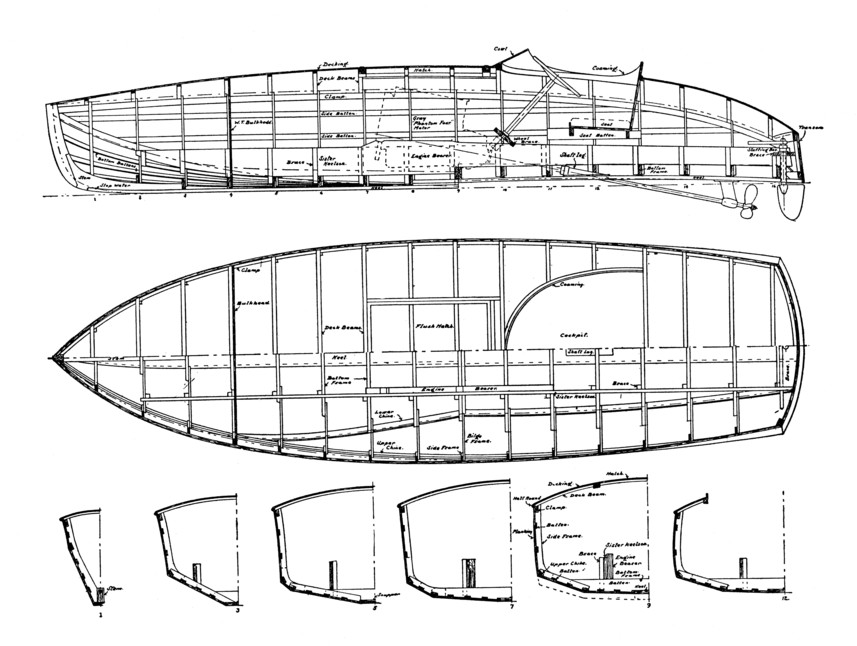

The possibilities for that area are endless. Also, if someone needs to be pulled out of the water after an exciting afternoon of water activities, they can drain off in the self-draining cockpit, and then change clothes underneath the bow. The rear cockpit is long enough for any guests to sleep under a tent if so desired. Also, with a curtain, there should be just enough room for a couple to spend the night.


At the bow, there is enough room underneath the foredeck to put anchors, dockines, lunch or whatever elese. The pilot and copilot get their own seperate seating in the front of the boat. Inside the cockpit, the seats line every opening and provide every opportunity for communicating with other passengers.

In the event of a rougue wave or a sudden rain storm, the cockpit is completely self-bailing. Much like the old boats, the deck is close to the water to reduce windage, and provide a greater sensation of speed. The transom is completely flat, which eliminates the possibility of inboard/outboards, and besides, who would want to reduce the amount of varnished wood on the transom? Those rebels deserve whatever water splashes their way. Most passengers should stay dry, except for someone hanging out in the stern. Of course, no mahogany runabout would be truly complete without a good deal of tumblehome at the transom. The sides of the boat are well flared towards the bow, and reach vertical about halfway through the length of the boat. The length of the boat, the deep V forward, and the position of the person driving the boat should prevent the bow from bouncing around too much. Planing boats are simply better balanced and more efficient with more weight in the stern. However, unlike the older boats, it was decided early on to place the engine in the stern. It should provide comfortable rinde without the ridicoulously high power consumption of modern deep V runabouts. In many ways, this is more similar to the older boats. The bottom starts at the bow with a deep convex V and ends in a shallow convex V at the stern. For no particular reason, I've always thought that runabouts should be exactly 21' long, and with that in mind, I started drawing the hull from the keel up. The boat I designed combines many of the aspects of a classic runabout with the modern understanding of interior layout and planing hull design. More modern boats have much better cockpit layouts, although I can't imagine why anyone would think a bowrider makes sense. Despite having an open layout, the centrally located engine compartment means the boat cockpit isn't really as open as it could be. The more open design of the Utility has it's problems though. When I was in highschool I even built a model Chris Craft Utility, and varnished it up, and I thought it looked great. I always thought the utility boats had potential for the same attractiveness as the more conventional mahogany runabout designs, but they rarely seem to have the same level of finish. I enjoy going out on a runabout partialy for the chance at human interaction in an entertaining environment. With the exception of some of the largest runabouts, each row of seating was seperated, limiting movement around the boat, and more importantly, limiting interactions with other people on the boat. While the double and triple cockpit runabouts looked alluring, I have always had a problem with them. Boats like the Chris Craft utility boats. I prefered, the boats next to the big mahogany runabouts. However, these were not the boats that attracted me the most. It was the large relatively flat surfaces that make a mahogany runabout so shiny and attractive. Of course, with enough varnish, time, and careful brush work, any boat could have that kind of varnish. It was like a layer of glass had been poured over the boats, giving them an indescribable amount of depth. I remember when they used to all get together at the Center for Wooden Boats in Seattle every year for the Wooden Boat Festival, and the docks would be lined with people starring through the massively thick coating of varnish at the beutiful mahogany underneath. The big mahogany runabout's of yesteryear are some of the nicest pieces of eye candy on the water. I'm sure most of the other competitors in this competition feel the same way. When I first saw Wooden Boat Magazine's boat design competition to design a modern wooden runabout, I was very excited.


 0 kommentar(er)
0 kommentar(er)
